Motorola Edge 50 Ultra Review: Flagship, but cheaper
We may earn a commission if you make a purchase from the links on this page.

Motorola Edge 50 Ultra Intro
The Edge 50 Ultra is Motorola's new flagship phone for 2024, and it certainly stands out with the option of a wooden back and features like super-fast 125-watt charging speeds that you won't find on a Galaxy or an iPhone.
At the same time, though, Motorola has cut some corners to make the Edge 50 Ultra a good deal for those who want a flagship, but cheaper. It uses a slightly less powerful processor and the camera quality might be just a bit behind the competition.
So overall, the price of £850 in the UK, seems like a pretty good deal, especially when you consider that this phone comes with a mind-boggling 16GB of RAM and 1TB of built-in storage, and that other options like the Galaxy S24 Plus or iPhone 15 Pro are priced at £1,000 or more.
As for the Motorola Edge 50 Ultra U.S. availability, so far we know nothing. In previous years, Motorola has sold its flagship Edge phones in the US, so this phone could also arrive at some point in the future.
Before we dive deeper, let's also clarify a thing about the name of this phone. Last year Motorola's flagship was the Edge 40 Pro, but this year the Edge 50 Pro is the mid-range model and this here Edge 50 Ultra is the flagship. Tricky stuff, but we guess Ultra is Motorola's new catchy word for 2024.
Table of Contents:
- Specs
- Design and Display
- Camera
- Performance
- Software
- Battery and Charging
- Audio Quality and Haptics
- Should you buy it?
Motorola Edge 50 Ultra Specs
Fully equipped
Let's start with an overview of the Edge 50 Ultra specs:
| Specs | Motorola Edge 50 Ultra |
|---|---|
| Size and Weight | 161.1 x 72.4 x 8.6mm |
| Display | 6.7-inch FHD+ OLED, 144Hz |
| Processor | Snapdragon 8s Gen 3 (3nm) |
| Software | Android 14 |
| Cameras | 50 MP main, f/1.6 50 MP ultrawide, f/2.0 64 MP telephoto, 3X zoom, f/2.4 50 MP front, f/1.9 |
| Battery Size | 4,500 mAh |
| Charging Speeds | 125 wired charging 50W wireless 10W reverse wireless |
| Prices | 16GB RAM/1TB for €1,000 16GB/1TB for £850 |
Motorola Edge 50 Ultra Design and Display
Stellar display and sleek design
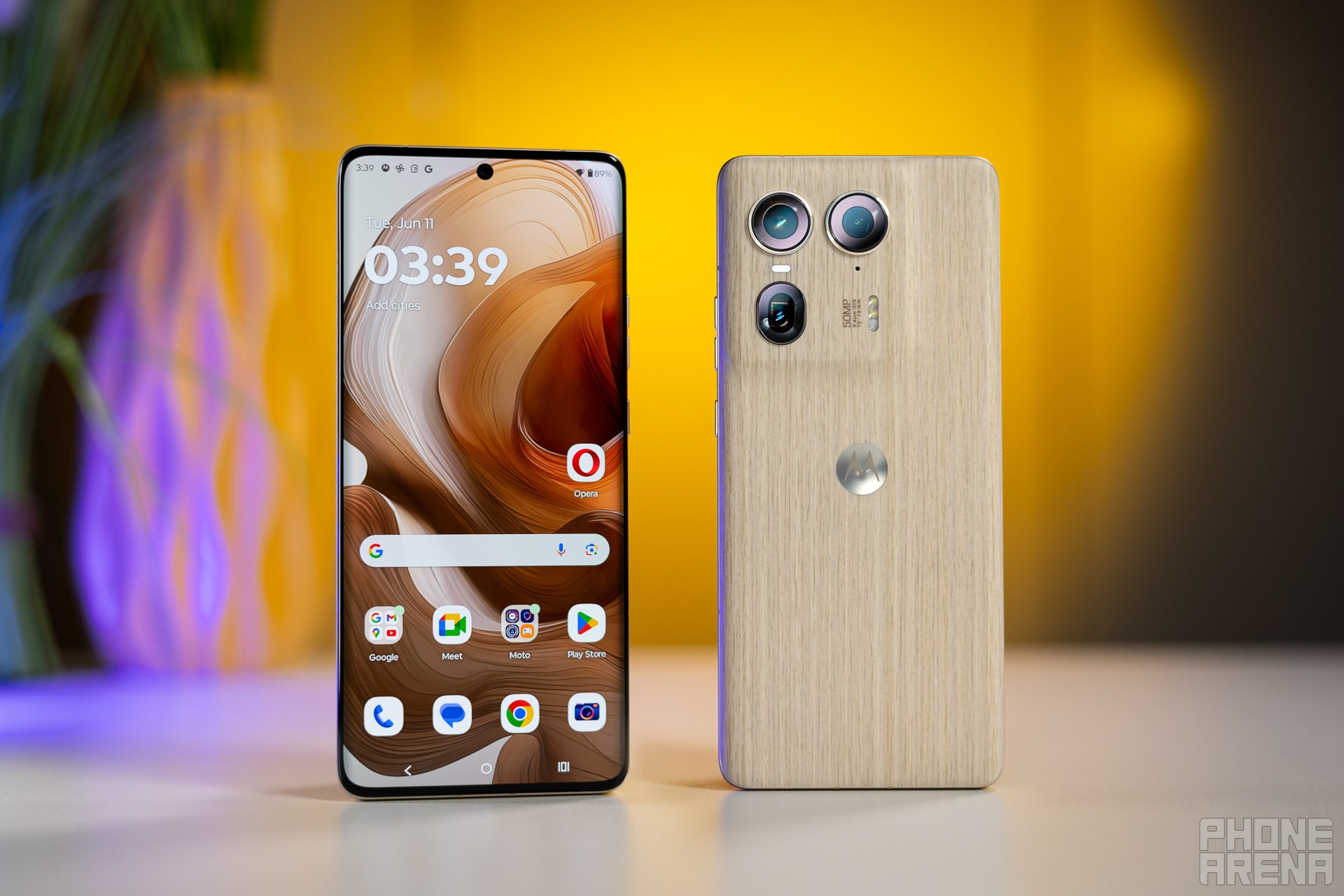
You can get a wooden back as an option, but you also have more traditional finishes like faux leather and glass (Image by PhoneArena)
The Motorola Edge 50 Ultra is a 6.7-inch phone that feels a bit smaller than your usual big flagship thanks to its curved sides. Its physical size is actually quite similar to the Edge 40 Pro model from last year, coming in at 161.1 x 72.4 x 8.6 mm.
It is definitely not as heavy as some of the competition, weighing in at just 197g, about 35g less than the Galaxy S24 Ultra, for example.
The design is not quite traditional though. The Edge 50 Ultra we have for review has a light wooden back, and you also have a black version with faux leather on the back, and a third, bronze color option with glass is available in some markets. We love that variety in both colors and materials, and we wish more flagships offered this much choice.
Speaking of the back, Motorola has altered the camera island, which used to look a bit messy in previous generations. Now it looks more orderly, almost like a blanket that only reveals the outlines of where the camera island is.
The frame of the phone is made out of aluminum, and not anything fancy like titanium.
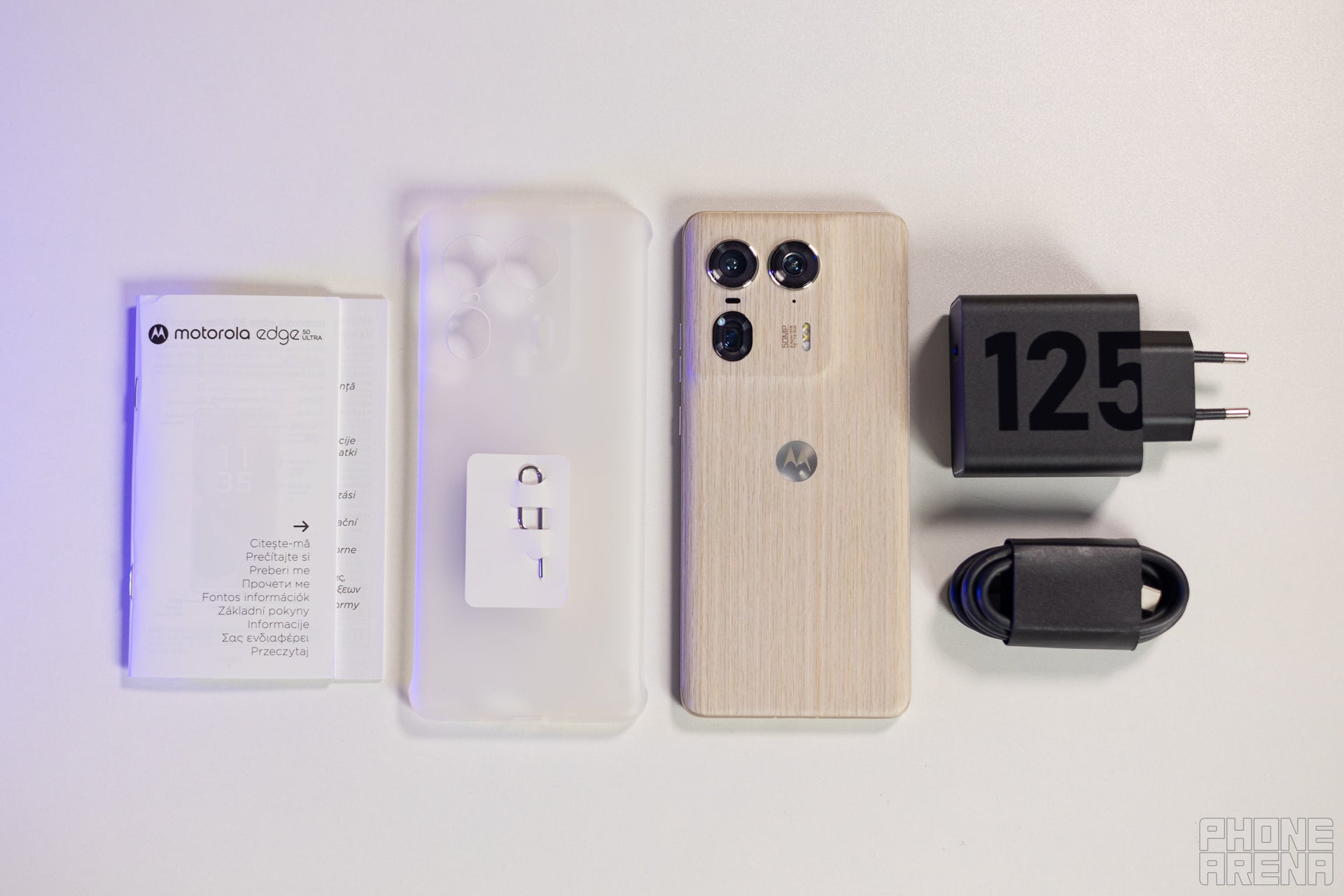
The 125W fast charger in the box is great to have (Image by PhoneArena)
As usual, when it comes to its more premium phones, Motorola is quite generous with the unboxing experience. The Edge 50 Ultra comes with a 125W charger and a USB-C cable, and even a case so that you immediately have protection. No pre-installed screen protector, though.
The display on the Edge 50 Ultra (and the rest of the Edge 50 family) is curved, which contrasts most of the other premium phones on the market as they tend to have flat displays. Naturally, this is a matter of personal preference, but an edge display seems fitting for a phone lineup that includes that word in its name.
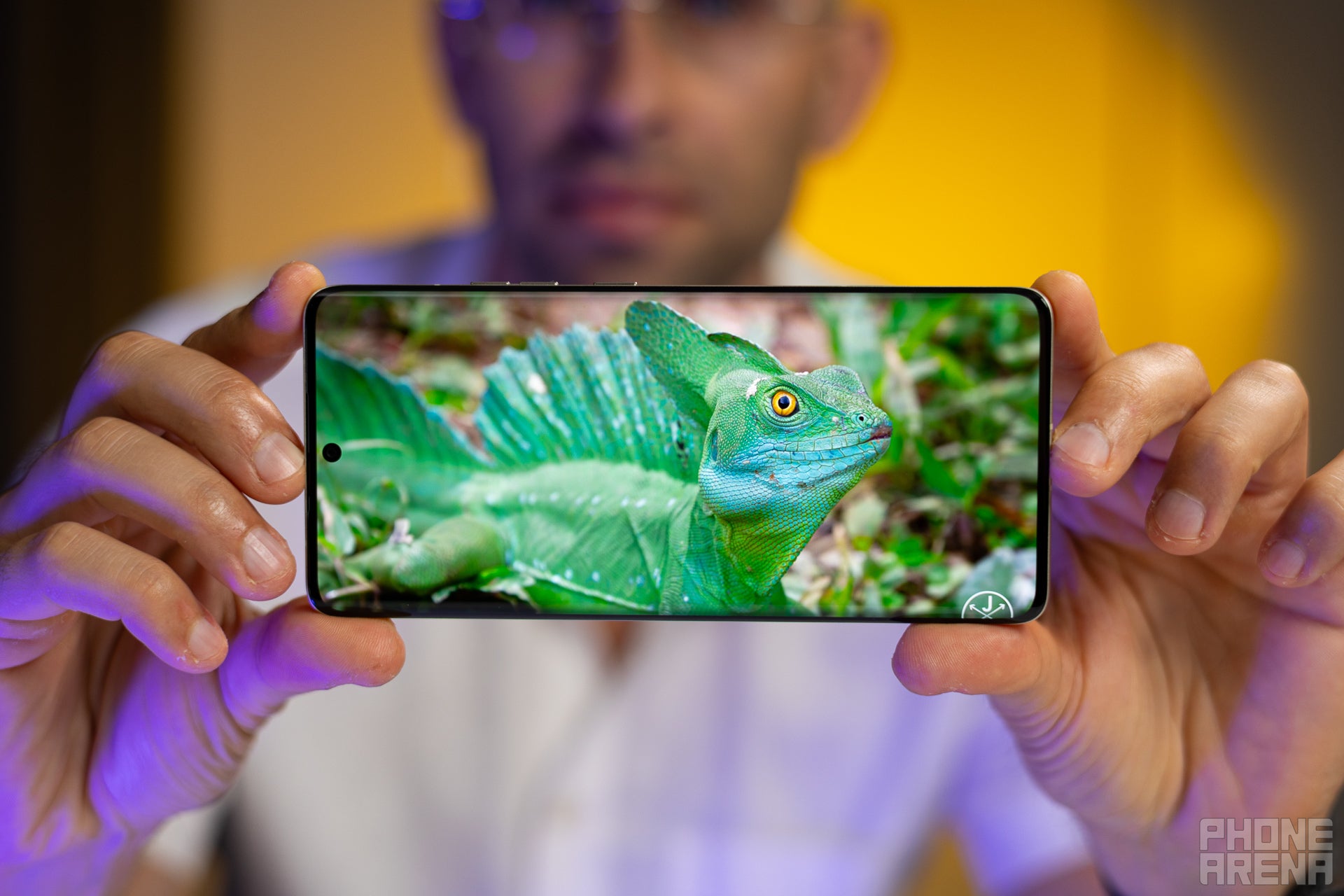
The screen gets plenty bright (Image by PhoneArena)
At the front, you get a 1220 x 2712 pixel P-OLED display with refresh rate of up to 144Hz. There's also support for HDR10+ content (no Dolby Vision support). It was a joy to experience any kind of content on this display and I could even use it in sunny conditions since it was perfectly visible.
Protecting this gorgeous display is Gorilla Glass Victus, although, given its curved nature I would definitely slap on a screen protector just in case one of the edges hits any hard surface by accident.
Biometrics-wize, you get an optical under-display fingerprint reader that is very fast and accurate. There is also 2D, image-based face recognition that can be even quicker than the fingerprint sensor, although, as usual, that option is not quite as secure.
Motorola Edge 50 Ultra Camera
Solid performance of the main camera, but the ultra-wide camera and video recording disappoints
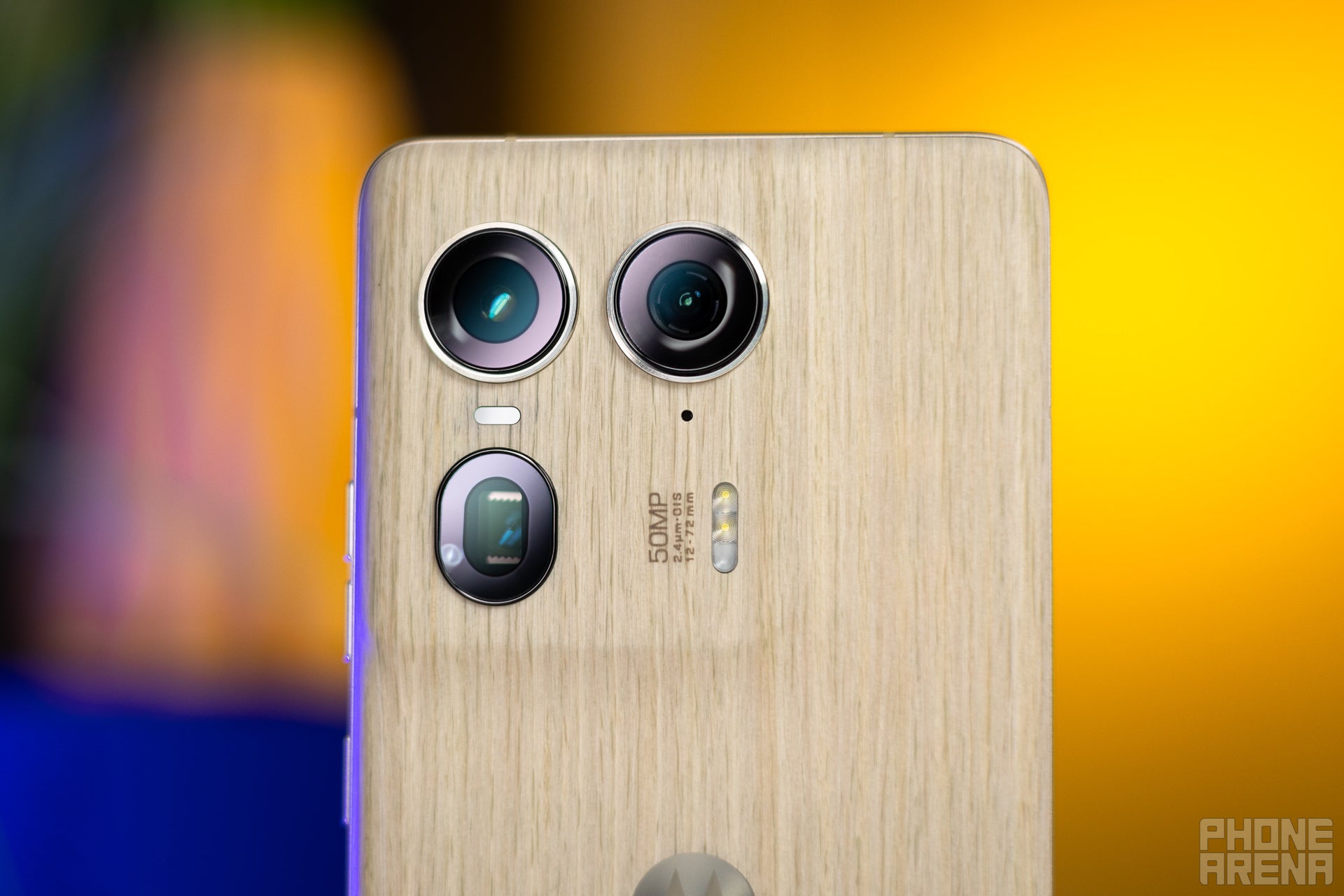
A triple rear camera system (Image by PhoneArena)
With three cameras on the back and a single front camera for selfies, the Motorola has got the hardware, but what about its actual performance?
On our comprehensive PhoneArena Camera Score, the Edge 50 Ultra scored well for photo qualtiy, but its video quality was disappointing. More on the scores for each camera in the sections below, but first, here's a quick look at the full Edge 50 Ultra camera specs:
- Main (wide): 50MP, f/1.6 aperture, Optical Image Stabilization (OIS)
- Ultra-wide: 50MP, f/2.0, Autofocus
- Telephoto: 64MP, 3X Zoom, f/2.4, Autofocus, OIS
- Front: 50MP, f/1.9, Autofocus
Main Camera
The main camera on the Edge 50 Ultra is definitely a solid performer. Images come out with pleasing colors, good dynamics and a quite decent amount of detail.
Among the issues with the main camera are slight oversharpening, which you would notice on a larger screen, as well as lack of HDR preview in the camera app, so what you see in the viewfinder will be different than the picture you actually capture.
As far as AI is concerned, there are a few features that aid the camera performance. For one, you have Action Shot, which is the phone's ability to adjust shutter speed and ISO in low-light environments to capture as much light as possible.
Lastly, we have the Auto Enhance feature, which actually comes from a master in photo editing software, Google. Motorola just decided to bake this feature into the camera app on the Edge 50 Ultra. Users have the option to choose from Natural (the default) and the Auto Enhance mode, the latter of which aims to edit the image so that it looks better.
Zoom Quality
When it comes to zoom quality, the native 3X zoom periscope lens performs fine and it helps that it has a wide, f/2.4 aperture, so it can capture more light and be used in low light too.
It's not all perfect though, and you can see some issues with a darker than ideal exposure in the above photos.
However, just in terms of pure detail, this zoom camera ranks very highly, beating even more renowned Galaxy and Google rivals.
Ultra-wide Camera
Unfortunately, the ultra-wide camera is a disappointment.
Detail is just not on par with other phones, and you have significant issues with oversharpening. In the corners, we see the quality drop noticeably as well.
Front Camera

Selfies come out okay, but we measured detail levels are a bit behind that on rivals in the same price class, and there is a bit of excessive sharpening applied to images.
Video Quality

You can record 4K video at 60FPS, and 1080P video at a maximum of 960FPS for slow motion. There's also an option to record in 10-bit HDR10+, although that would take up a lot of space.
Next, we have Auto Focus Tracking, which helps keep subjects moving fast inside the frame clear to see when recording videos. Another video feature, and the more important one in my opinion, is the Adaptive Stabilization, which adjusts the stabilization based on how you are holding the phone and your movements.
Motorola Edge 50 Ultra Performance
Slightly less powerful chip, but 16GB of RAM and 1TB of storage... wow!
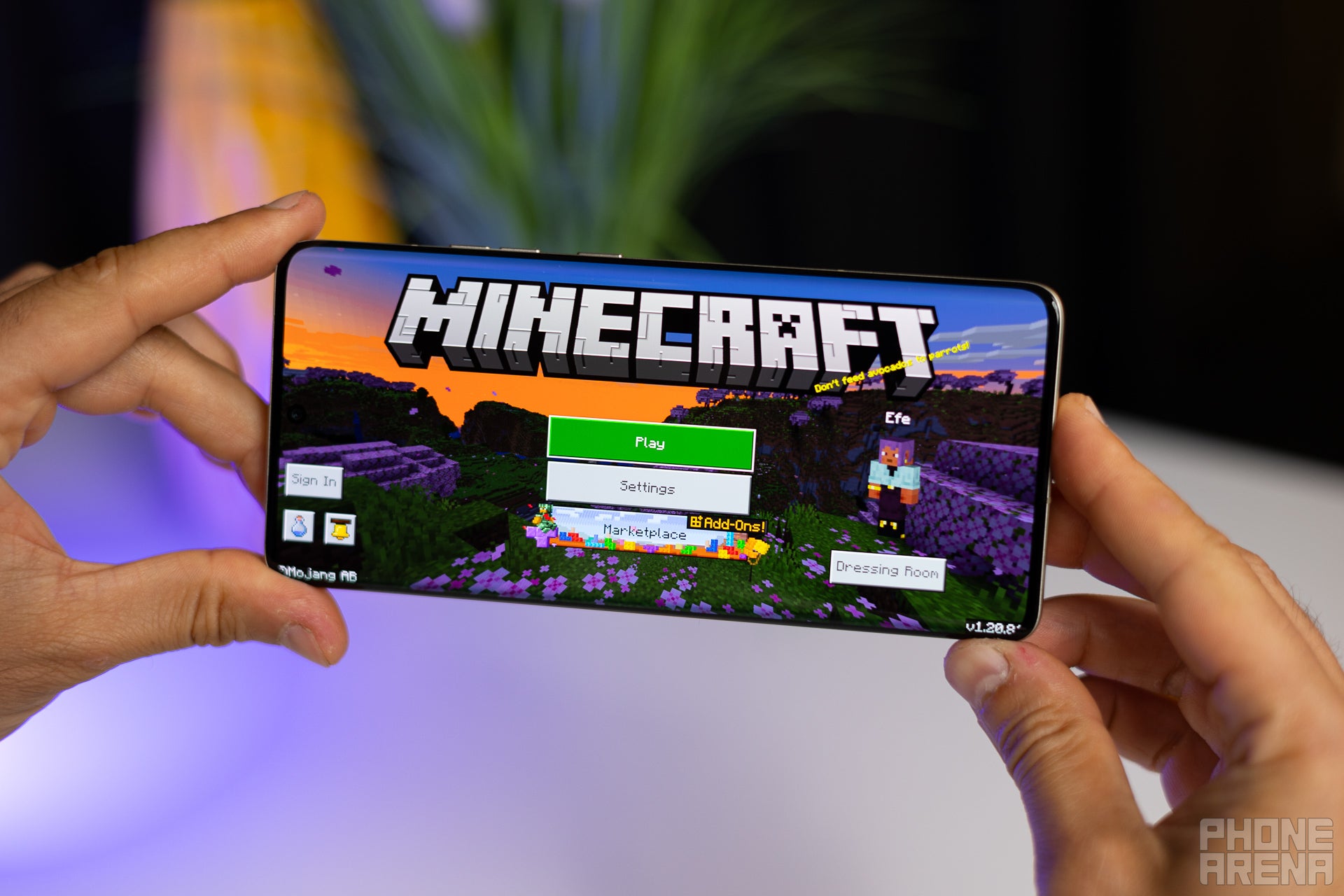
The chip is not the most powerful around, but you get way more RAM and storage than on rivals (Image by PhoneArena)
The one area where Motorola has cut some corners is the performance. Inside the Edge 50 Ultra you have the Snapdragon 8s Gen 3 processor, a slightly less powerful version compared to the 8 Gen 3 that you see on most 2024 Android flagships.
On the flip side, this chipset might just be more power efficient, which we imagine some people will prefer over the boost in power.
Performance Benchmarks:
In CPU performance on the Geekbench 6 test, we see the Motorola is slightly behind the Galaxy S24 series, but faster than the Pixel 8 series, powered by the Google Tensor 3 chipset.
The bigger gap, however, is in gaming where a Galaxy performs way better.
Funny enough, even last year's Motorola Edge 40 Pro beats this Edge 50 Ultra in gaming performance!
It's not all bad, though. The Edge 50 Ultra makes up with a whopping 16 GB of LPDDR5X RAM on board, the most we have seen in a flaghips. The version sold in the UK and Europe also comes with 1TB of on board storage! Wow!
Motorola Edge 50 Ultra Software
Software, however, is the one area I think Motorola could and should improve the most.
The Edge 50 Ultra comes with Android 14 straight out of the box, and a Motorola's Hello UI skin on top of it. That includes familiar features such as the twist gesture to turn on the camera even while the phone is locked, or the chop gesture to turn on the flashlight.
But then come the disappointments.
You only get 3 years of Android updates and 4 years of security patches, while Galaxies and Pixels now come with a seven year update commitment.
Our unit also came with pre-installed bloatware with some low-quality games, and even Motorola's weather app comes with ads (it uses 1Weather), and you need to pay for the premium version to get rid of those ads.
Stock widgets appear broken too, the Google At a Glance widget took up two rows of icons, instead of one. Simple things like Motorola's choice of sound effects for notifications also just don't sound right. In some places, it seems like someone at Motorola just took stock Android with little extra thought or refinement.
There are some new features worth mentioning, of course. AI is now here with generative wallpapers, a gimmick maybe, but still nice to see. Motorola has its own twist on this: you can generate a wallpaper based on a photo of your clothing, something I quite liked on the more affordable Edge 50 Pro.
Other than that, there are no built-in generative AI features like the ones you would find on the Galaxy S24 or Pixel 8, unfortunately. Of course, you can always download the Gemini app, and have it replace your Google Assistant with something way more powerful.
Motorola Edge 50 Ultra Battery
The complete charging package
Fast charging is never an after-thought on Motorola phones, and the Edge 50 Ultra comes with 125W charging via a wired, but also 50W wireless charging and 10W reverse wireless charging. Those are insanely fast speeds!
But let's first take a look at the battery life, as we have a 4,500mAh battery size here, so the battery is smaller than most other Android phones.
PhoneArena Battery Test Results:
On our lightest, web browsing test, the Motorola scored a bit more than 14 hours and a half, which is about average, and not really all that impressive.
Interestingly, on our second YouTube video streaming test, it faired way better, lasting nearly 11 hours, more than the average, beating the Galaxy S24 Ultra and Pixel 8 Pro by a good margin.
Finally, on our 3D gaming test, which stresses the GPU, the Motorola absolutely killed it, lasting again over 11 hours. This might be due to the underclocked GPU in the chipset, and as we saw in the performance benchmarks, it's not the fastest chip, but it looks to be very power efficient, especially for gaming.
PhoneArena Charging Test Results:
With a 4,500mAh on board the phone can charge from 1-100% in about half an hour, truly impressive.
The 10W reverse wireless charging is also super neat in case you decide to buy Motorola's first wireless earbuds, the Moto Buds Plus, or any other earbuds that allow wireless charging.
The 10W reverse wireless charging is also super neat in case you decide to buy Motorola's first wireless earbuds, the Moto Buds Plus, or any other earbuds that allow wireless charging.
50W wireless charging is also pretty neat, as long as you have a wireless charger that supports this level of charge output. Unfortunately, we could not test wireless charging speeds on this phone.
Motorola Edge 50 Ultra Audio Quality and Haptics
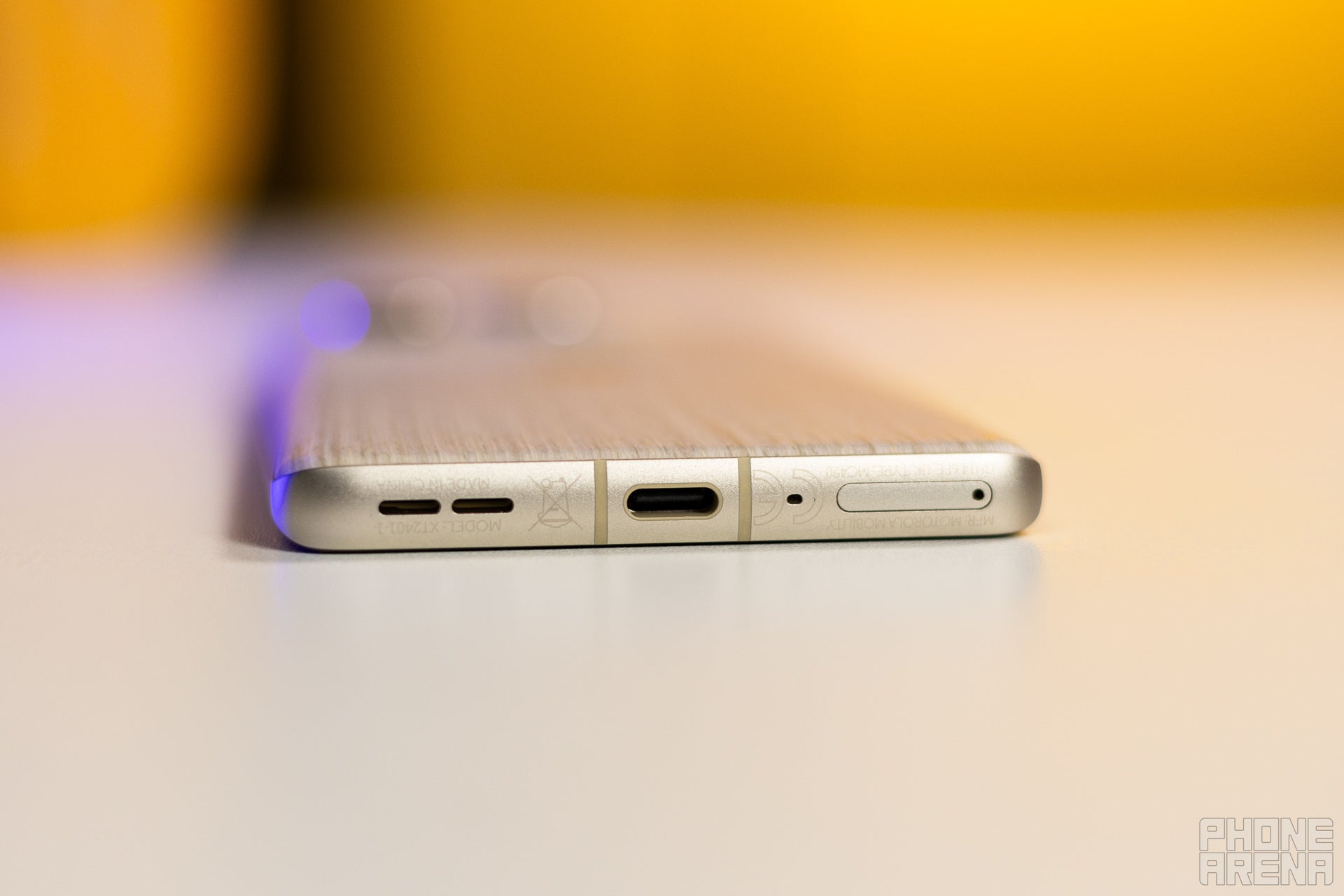
Sound via the loudspeakers is quite good (Image by PhoneArena)
With dual, stereo loudspeakers, the Edge 50 Ultra delivers quite good sound quality and there is almost no distortion at the maximum volume level.
We, however, left wanting a bit more oomph and power, as that seems to be lacking.
Haptics on the Edge 50 Ultra felt decently good and sharp, but not quite on par with the best phones in this regard, which would be the iPhone series and the OnePlus 12.
Sadly, like almost all other phones on the market nowadays, the Edge 50 Ultra has no 3.5mm audio jack, so you would have to depend on USB-C connectors or Bluetooth headphones.
Should you buy it?
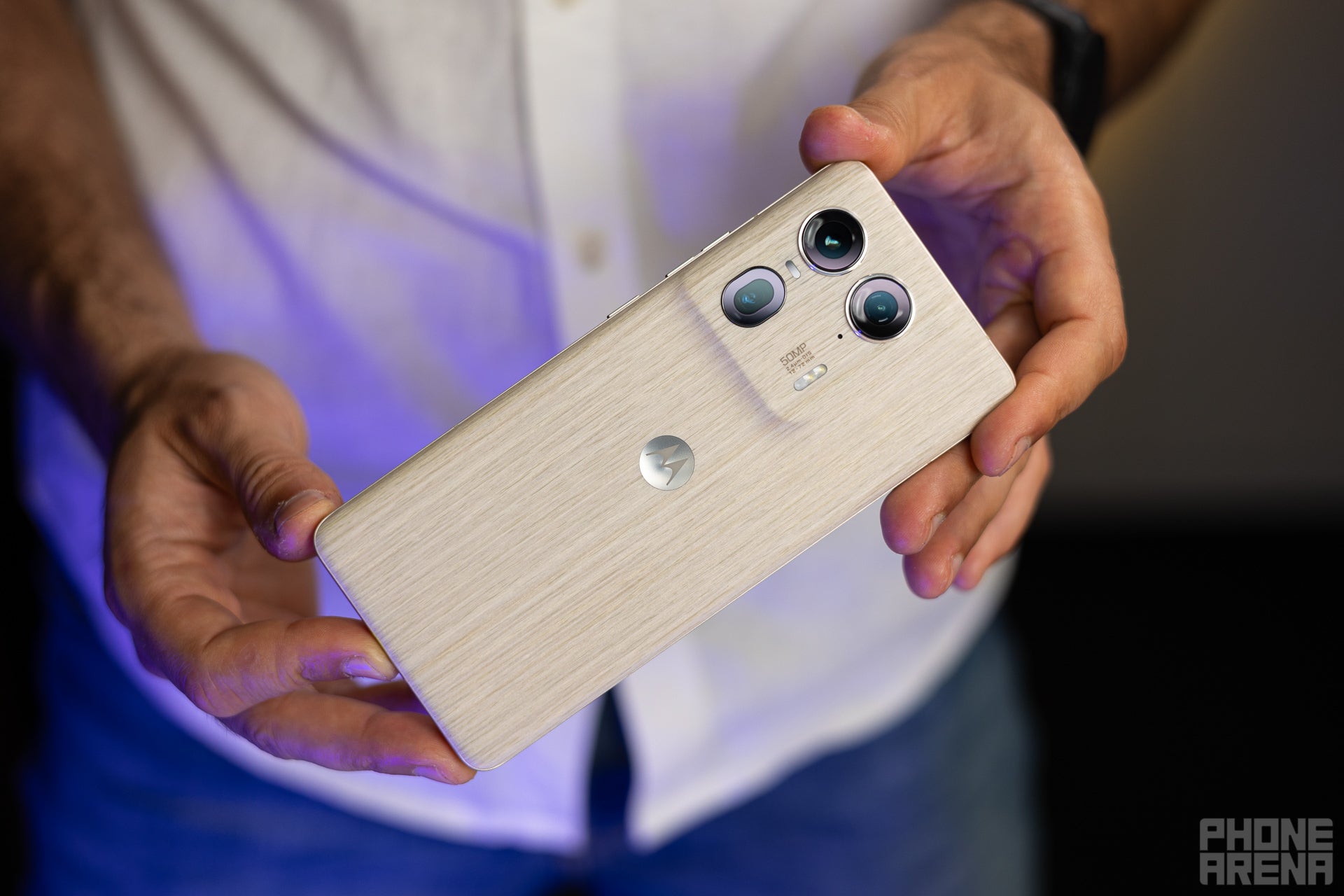
The Edge 50 Ultra has some quirks, but it is good value for the money (Image by PhoneArena)
At the end of the day, with the Edge 50 Ultra, Motorola has made a flagship that is cheaper than the competition and that offers good value for the money, but with some quirks you should know about.
You get a triple camera system, you get the fast charging, you get more RAM and storage than you might ever need. You also get a phone with a stand-out and quite sleek design.
To arrive at that lower price, Motorola has used a slightly less powerful chipset, but one that seems to be very power efficient. Unless you are a gamer who wants the best in performance, you probably should not be bothered by this. The camera system is also not quite the best one we have seen, and especially the ultra-wide camera and video quality take a hit.
We would also place software in the list of things to be cautionate about: the bloatware, the shorter software update commitment, and just the lack of attention to detail.
You have the Galaxy S24 series as the obvious alternative with a better camera and more refined software, but it costs more. Another option you should consider is the Google Pixel 8 Pro, which sells for a similar price, but offers a better camera (however, no fast charging or that much storage space).
Follow us on Google News






















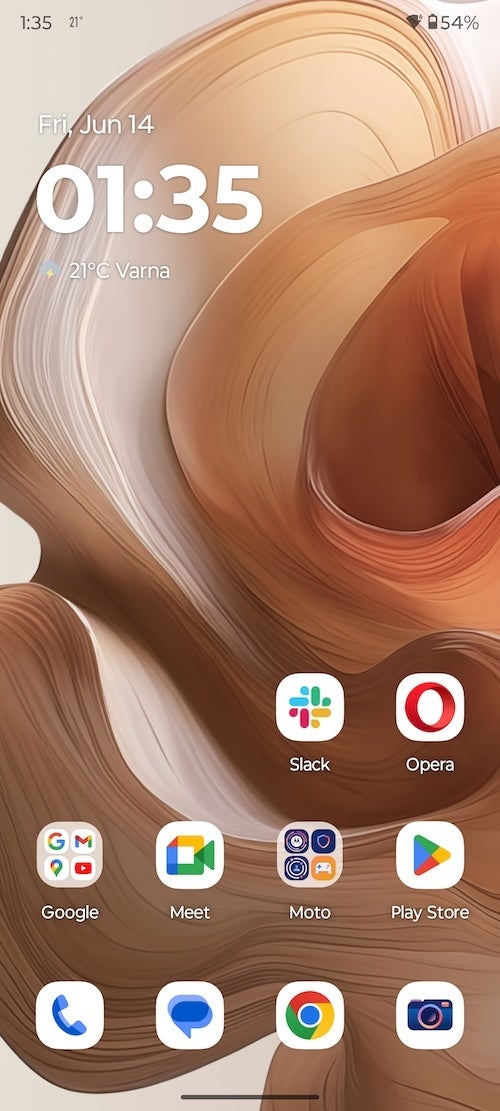

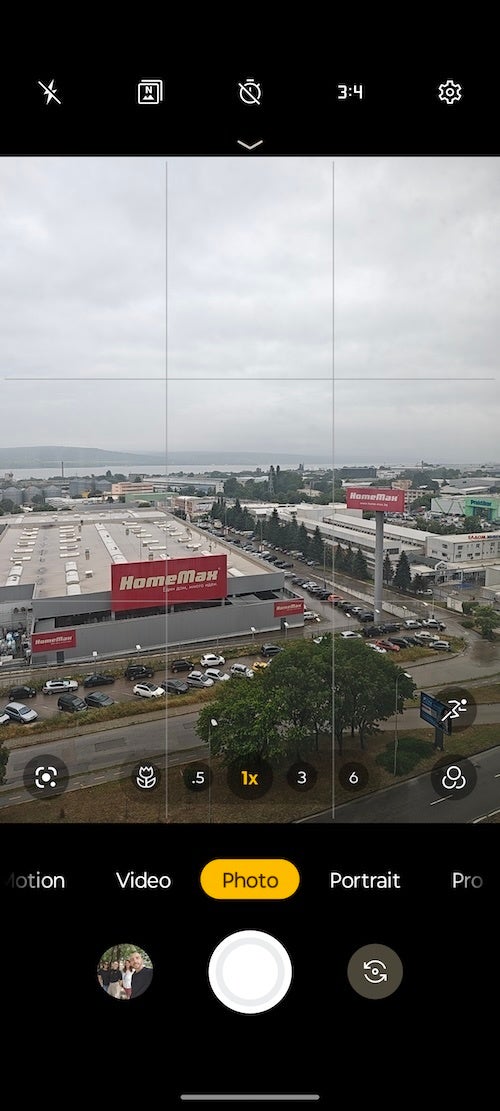
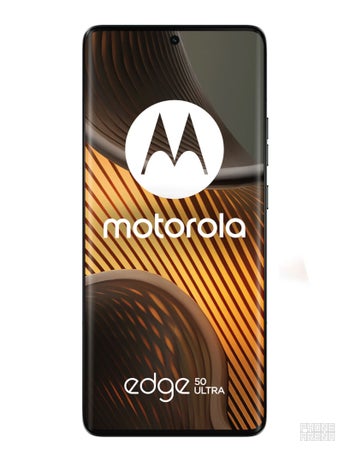













Things that are NOT allowed:
To help keep our community safe and free from spam, we apply temporary limits to newly created accounts: